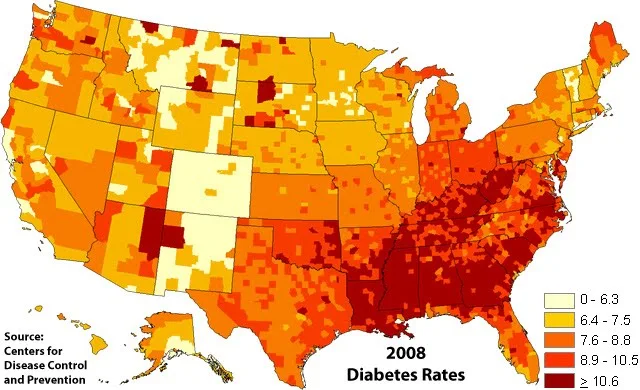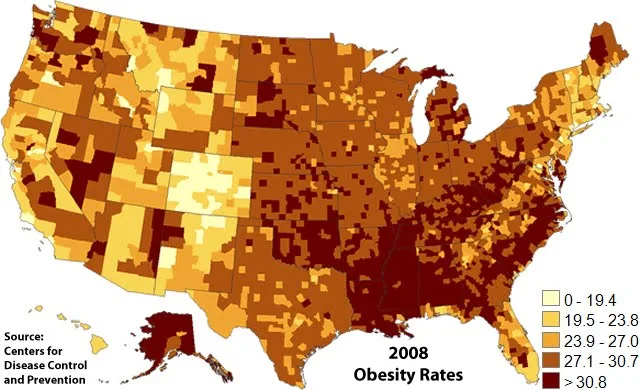By Susan Cheever
May 23, 2012
“When it comes to our national obesity epidemic, the elephant in the room is
getting so fat that he can hardly stagger into the den to watch his favorite
programs. From medical pundits to life coaches to health websites to the
Centers for Disease Control and Prevention to First Lady Michelle Obama,
theories abound about why we can’t stop gaining those ugly pounds.
"The
Weight of the Nation," a four-part HBO documentary about
the many costs of our growing fat problem, airs tonight and tomorrow. Last
week's Newsweek cover featured a baby hugging
a serving of French fries and the tagline: "When I grow up, I'm going to
weigh 300 pounds. Help!" And a just-released CDC report offers no
comfort with predictions that, indeed, by 2030, 42% of Americans will be obese,
and 11% will be severely obese. Suffice it to say, we're having a major fat
moment.
Looking at a US obesity map, some say it is a Red State syndrome, a cultural trait in tandem with being a Republican. Others say that obesity is related to poverty ~ since healthy eating tends to be expensive (fresh fruit and vegetables, whole grains, lean meats and chicken, fish), those with less money eat more junk. Some say it stems from a lack of information about nutrition.
Others blame our sedentary culture: instead of going for the brisk walks of yesteryear we veg out ~ “chip out” is more like it ~ in front of the television or the computer after sitting on our asses all day at work.
According to the CDC, obesity is caused by genes,
metabolism, behavior, environment, culture and socioeconomic status. (For an
interesting comparison of maps showing county-by-county rates of obesity,
inactivity and diabetes, go here.)
Back to the elephant in the room: We keep getting fatter and fatter because we are overlooking, if not ignoring, an important cause of obesity ~ addiction. Certain foods, like certain drinks, trigger an addictive reaction in many people. Once eaten, these foods create a craving for more, more, more. “Bet you can’t eat just one,” the old Lays Potato Chips ad, is as good a definition of alcoholism (or any addiction) as I know.
Back to the elephant in the room: We keep getting fatter and fatter because we are overlooking, if not ignoring, an important cause of obesity ~ addiction. Certain foods, like certain drinks, trigger an addictive reaction in many people. Once eaten, these foods create a craving for more, more, more. “Bet you can’t eat just one,” the old Lays Potato Chips ad, is as good a definition of alcoholism (or any addiction) as I know.
For most addicts, the only “cure”
is to abstain entirely from the craving-triggering food. But that’s hard to do
in a world chockablock with yummy fats, fried foods, sugary treats and gooey
deliciousness ~ and ads featuring them everywhere you turn.
There are two kinds of foods: those that satisfy hunger and those that create hunger ~ a craving that can never be satisfied until the box is empty. In my household ~ where addiction has many causes ~ we say that those foods talk to us. “
There are two kinds of foods: those that satisfy hunger and those that create hunger ~ a craving that can never be satisfied until the box is empty. In my household ~ where addiction has many causes ~ we say that those foods talk to us. “
Susan,” the leftover pizza will croon, “I won’t be as good tomorrow. Eat me now!”
“Much of the scientific research
around overeating has been physiology ~ what's going on in our body,” writes
Harvard-trained pediatrician and former FDA commissioner Dr. David Kessler.
“The real question is what's going on in our brain.”
In his 2009 bestseller "The End of Overeating: Taking Control of the Insatiable
American Appetite," Kessler, who during his seven-year tenure
at the FDA reinvented the food label and attempted to regulate cigarettes,
describes how our brains get hooked on sugar, fat and salt.
He accuses the food industry and
restaurant chains of engineering foods to be increasingly addictive just as the
tobacco industry does with cigarettes.
They scientifically experiment with taste, texture, color, smell, look ~ and above all the empty calories of sugar, fat and salt ~ to come as close as possible to eating’s “bliss point,” in Kessler’s words, where the brain’s reward system is captured by this immensely complex, artificially designed food that is as powerful as a drug.
These insidiously plotted confections do much more than satisfy hunger and
deliver calories to burn as energy; they stimulate our brains by releasing
feel-good dopamine in the same way as, say, cocaine.
Once the food is consumed, the
brain is flooded with calming opiates; over time, the mere visual or verbal
suggestion of these foods trigger this dopamine-opiate craving and the desire ~
rather than the need ~ to eat. Furthermore, as any shopper can attest, the most
addictive foods are the most available, the most attractively packaged and often
the least expensive.
It's no accident, for example, that stacks of chocolate stand guard at the check-out line in most Trader Joe's ~ right across from the stacks of beer. This over stimulating environment results in what Kessler calls “conditioned hypereating.” For anyone who has struggled with those last few cookies in the box, Kessler’s theory rings true.
It took me years to figure out that there are certain foods ~ in my case, sugars and certain carbohydrates ~ that just make me hungrier for more no matter how much I have already eaten. Like Kessler (who said he spent seven years writing the book in order to understand how chocolate chip cookies could have such power over him, causing his weight to yo-yo from 160 pounds to 230), I could not figure out how I, a college-educated smart person, could eat a whole loaf of bread in a single sitting while promising myself that each slice would be the last.
It's no accident, for example, that stacks of chocolate stand guard at the check-out line in most Trader Joe's ~ right across from the stacks of beer. This over stimulating environment results in what Kessler calls “conditioned hypereating.” For anyone who has struggled with those last few cookies in the box, Kessler’s theory rings true.
It took me years to figure out that there are certain foods ~ in my case, sugars and certain carbohydrates ~ that just make me hungrier for more no matter how much I have already eaten. Like Kessler (who said he spent seven years writing the book in order to understand how chocolate chip cookies could have such power over him, causing his weight to yo-yo from 160 pounds to 230), I could not figure out how I, a college-educated smart person, could eat a whole loaf of bread in a single sitting while promising myself that each slice would be the last.
Now, I refer to bread as “the staff of death.”
Melodramatic perhaps, but having
identified the foods to which I am addicted and having succeeded in avoiding
them, I lead a healthier, happier and thinner life.
Here is the key to weight loss for those with addictive tendencies: identify the foods that speak to you, the ones that excite your cravings, and do not eat them!
Kessler calls it “food rehab” ~ rewiring
the brain so that the foods that we formerly craved as “guilty pleasures” now
trigger disgust ~ or at least the recognition that “eating the whole thing will
not make me feel good.
Although Kessler’s book sparked a great deal of attention to the issue of obesity as addiction when it was published three years ago, since then little progress has been made in the US or the rest of the world.
Somehow, the food industry has
failed to reform itself; the CDC and the World Health Organization have failed
to include the scarlet A for addiction on their websites or in their statistical
analyses of obesity; and populations have failed to rise up and throw away
their Little Debbies and Pringles, their Dove Bars and Mountain Dews. And where
are all the food rehabs?
The signs are all too easy to read: as long as we are so afraid of the stigma of addiction that we can’t even mention it in the public discourse, we will continue to wonder why, oh why, we can’t eat just one ~ and we will continue to get fatter.
The signs are all too easy to read: as long as we are so afraid of the stigma of addiction that we can’t even mention it in the public discourse, we will continue to wonder why, oh why, we can’t eat just one ~ and we will continue to get fatter.




No comments:
Post a Comment
If your comment is not posted, it was deemed offensive.